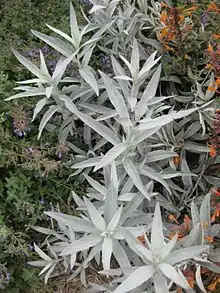Artemisia ludoviciana
Artemisia ludoviciana is a North American species of flowering plant in the daisy family Asteraceae, known by several common names, including silver wormwood, western mugwort, Louisiana wormwood, white sagebrush, and gray sagewort.[2][3]
| Artemisia ludoviciana | |
|---|---|
 | |
| Scientific classification | |
| Kingdom: | Plantae |
| Clade: | Tracheophytes |
| Clade: | Angiosperms |
| Clade: | Eudicots |
| Clade: | Asterids |
| Order: | Asterales |
| Family: | Asteraceae |
| Genus: | Artemisia |
| Species: | A. ludoviciana |
| Binomial name | |
| Artemisia ludoviciana | |
| Synonyms[1] | |
|
Synonymy
| |

Ludoviciana is the Latinized version of the word Louisiana.
Description
Artemisia ludoviciana is a rhizomatous perennial growing to heights between 0.33–1 metre (1.1–3.3 ft). The stems bear linear leaves up to 11 centimeters long. The stems and foliage are covered in woolly gray or white hairs.
The top of the stem is occupied by a narrow inflorescence of many nodding (hanging) flower heads. Each small head is a cup of hairy phyllaries surrounding a center of yellowish disc florets and is about half a centimeter wide.
The fruit is a minute achene.
Distribution
The plant is native to North America where it is widespread across most of the United States, Canada, and Mexico.[2][3][4][5] Some botanists suggest that eastern United States populations have been introduced from the western and central part of the continent.[6]
Subspecies
- Artemisia ludoviciana subsp. albula (Wooton) D.D.Keck—deserts from California + Colorado to Chihuahua, Sonora, Baja California
- Artemisia ludoviciana subsp. candicans (Rydb.) D.D.Keck—Rocky Mountains + Cascade Range from Alberta + British Columbia to California + Colorado
- Artemisia ludoviciana subsp. incompta (Nutt.) D.D.Keck—mountains from Alberta + British Columbia to Mexico
- Artemisia ludoviciana subsp. ludoviciana—western + central United States + western Canada
- Artemisia ludoviciana subsp. mexicana (Willd. ex Spreng.) D.D.Keck—Mexico as far south as Puebla; United States as far north as Colorado + Missouri
- Artemisia ludoviciana subsp. redolens (A.Gray) D.D.Keck—Durango, Chihuahua, Arizona, New Mexico, Texas
- Artemisia ludoviciana subsp. sulcata (Rydb.) D.D.Keck—Chihuahua, Sonora, Arizona
Uses
Native Americans
Native Americans used the species as a medicinal plant, a source of fiber for crafting household items, and for ceremonial purposes.[8] The Dakotas used this plant to protect against maleficent powers. The Apache, Chiricahua and Mescalero used this plant for spices[9] while Blackfoot tribe used it as a drug for dermatological purposes.[10] Gros Ventre also used it for skin curing as well as medicine against cold, because it also antipyretic.[11]
Cultivation
Artemisia ludoviciana is cultivated as an ornamental plant.[12] Being rhizomatous, it can spread aggressively in some climates and gardens.
Popular cultivars include 'Valerie Finnis' and 'Silver Queen.' Both are hardy to USDA zone 4. 'Valerie Finnis' has held the Royal Horticultural Society's Award of Garden Merit since 1993.[13]
References
- The Plant List Artemisia ludoviciana Nutt.
- National Plant Germplasm System−GRIN.gov: Artemisia ludoviciana Retrieved 26 November 2017.
- Flora of North America Vol. 19, 20 and 21 Page 527 Silver wormwood, white or silver sage Artemisia ludoviciana Nuttall, Gen. N. Amer. Pl. 2: 143. 1818.
- Berendsohn, W.G. & A.E. Araniva de González. 1989. Listado básico de la Flora Salvadorensis: Dicotyledonae, Sympetalae (pro parte): Labiatae, Bignoniaceae, Acanthaceae, Pedaliaceae, Martyniaceae, Gesneriaceae, Compositae. Cuscatlania 1(3): 290–1–290–13
- Turner, B. L. 1996. The Comps of Mexico: A systematic account of the family Asteraceae, vol. 6. Tageteae and Athemideae. Phytologia Memoirs 10: i–ii, 1–22, 43–93
- Biota of North America Program: county distribution map Retrieved 26 November 2017.
- Keck, David Daniels 1946. A revision of the Artemisia vulgaris complex in North America. Proceedings of the California Academy of Sciences, Series 4, 25(17): 421-468 descriptions, line drawings, range maps of several species
- University of Michigan @ Dearborn, Native American Ethnobotany of Artemisia ludoviciana Retrieved 26 November 2017.
- Castetter, Edward F. and M. E. Opler (1936). Ethnobiological Studies in the American Southwest III. The Ethnobiology of the Chiricahua and Mescalero Apache. 4. University of New Mexico Bulletin. p. 47.
- Hellson, John C. (1974). Ethnobotany of the Blackfoot Indians, Ottawa. Mercury Series. National Museums of Canada. pp. 17–124.
- Hart, Jeff (1992). Montana Native Plants and Early Peoples, Helena. Montana Historical Society Press. p. 44.
- Las Pilitas Horticulture Database: Artemisia ludoviciana (White Sagebrush) Retrieved 26 November 2017.
- "RHS Plant Selector - Artemisia ludoviciana 'Valerie Finnis'". Retrieved 23 February 2020.
External links
| Wikimedia Commons has media related to Artemisia ludoviciana. |